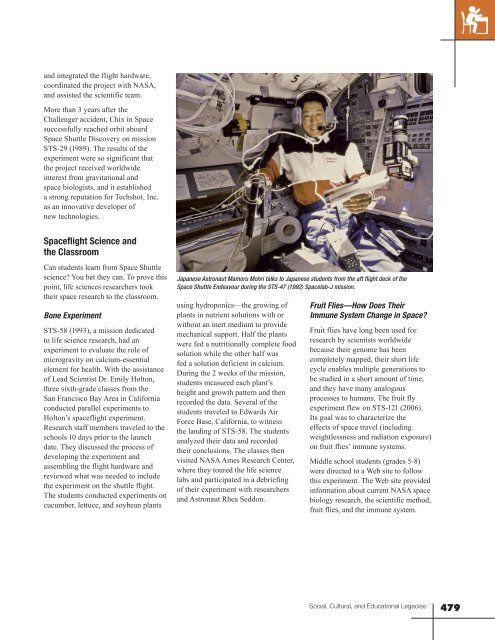Sciences Corporation,11 years laterbecoming the proud IT Project Manager.I often think about how different mycareer path may have been without theGet Away Specials Program <strong>and</strong> all ofthe doors it opened for me.”The Get Away Specials Program wassuccessful for both high school <strong>and</strong>university students. Over the years, itchanged to the Space ExperimentModule Program, which simplified theprocess for students <strong>and</strong> teachers.Space Experiment ModulesTo reduce costs to get more studentsinvolved, <strong>NASA</strong> developed the SpaceExperiment Module Program sincemuch of the engineering to power <strong>and</strong>control experiments was done for thestudents. Space Experiment Moduleexperiments, packaged 10 modules to apayload canister, varied from active(requiring power) to passive (nopower). Since no cost was involved,students in kindergarten as well ascollege students proposed projects.During the mid 1990s, 50 teachers fromthe northeastern United States,participating in the <strong>NASA</strong> <strong>Educational</strong>Workshops at Goddard Space FlightCenter <strong>and</strong> Wallops Flight Facility,designed Space Experiment Moduleswith activities for their students.During this 2-week workshop, teacherslearned about the engineering designprocess <strong>and</strong> designed module hardware,completed the activities with theirstudents, <strong>and</strong> submitted theirexperiment for consideration. One ofthe Get Away Special cans on STS-88(1998) contained a number of SpaceExperiment Module experimentsfrom <strong>NASA</strong> <strong>Educational</strong> Workshopsparticipants. Students <strong>and</strong> teachersattended integration <strong>and</strong> de-integrationactivities as well as the launch.Martin Crapnell, a retired technologyeducation teacher who attended oneof the <strong>NASA</strong> <strong>Educational</strong> Workshopsessions, explained.“Experiencing the tours, briefings,<strong>and</strong> launch were once-in-a-lifetimeexperiences. I tried to convey thatexcitement to my students. The SpaceExperiment Modules <strong>and</strong> <strong>NASA</strong><strong>Educational</strong> Workshops experienceallowed me to share many things withmy students, such as the physics ofthe thrust at launch <strong>and</strong> the ‘twang’of the shuttle, long-term space travel<strong>and</strong> the need for food (SpaceExperiment Modules/Mars Lunchbox),spin-offs that became life-savingdiagnostics <strong>and</strong> treatments (especiallymine), job opportunities, <strong>and</strong>manufacturing <strong>and</strong> equipment that wassimilar to our Technology Lab.“Even though delays in receiving allof the Space Experiment Modulesmaterials affected the successfulcompletion we desired, I believe I wasable to share the experience <strong>and</strong> createmore excitement <strong>and</strong> underst<strong>and</strong>ingamong the students as a result of theattempt. The Space Experiment Modules<strong>and</strong> <strong>NASA</strong> <strong>Educational</strong> Workshopsexperiences allowed relevant transfer tolab <strong>and</strong> life experiences.”A Nutty Experiment of InterestOne of the many experiments conductedby students during the Space ShuttleProgram was to determine the effects ofmicrogravity <strong>and</strong> temperature extremeson various br<strong>and</strong>s of peanut butter.Students microscopically examined thepeanut butters, measured their viscosity,<strong>and</strong> conducted qualitative visual,spreadability, <strong>and</strong> aroma tests on thesamples before <strong>and</strong> after flight. Thestudents from Tuttle Middle School,South Burlington, Vermont, <strong>and</strong> TheGilbert School, Winsted, Connecticut,called this research “a nutty idea.”Students Go On to Careersin EngineeringJohn Vellinger, executive vice president<strong>and</strong> chief operating officer of Techshot,Inc. (Greenville, Indiana), is anexample of how one participatingstudent secured a career in engineering.As an eighth-grade student in Lafayette,Indiana, Vellinger had an idea for ascience project—to send chicken eggsinto space to study the effects ofmicrogravity on embryo development.Vellinger entered his project in ascience competition called the ShuttleStudent Involvement Program,sponsored by <strong>NASA</strong> <strong>and</strong> the NationalScience Teachers Association.In 1985, after Vellinger’s freshman yearat Purdue University, <strong>NASA</strong> pairedhim with Techshot, Inc. co-founderMark Deuser who was working as anengineer at Kentucky Fried Chicken(KFC). Through a grant from KFC,Deuser <strong>and</strong> Vellinger set out to developa flight-ready egg incubator.By early 1986, their completed“Chix in Space” hardware waslaunched aboard Space ShuttleChallenger on its ill-fated STS-51L(1986) mission. Regrouping after thetragic loss of the shuttle, its crew, <strong>and</strong>the Chix in Space incubator, Deuser<strong>and</strong> Vellinger continued to developthe payload for a subsequent flight.Together, the pair designed, fabricated,478<strong>Social</strong>, <strong>Cultural</strong>, <strong>and</strong> <strong>Educational</strong> <strong>Legacies</strong>
<strong>and</strong> integrated the flight hardware,coordinated the project with <strong>NASA</strong>,<strong>and</strong> assisted the scientific team.More than 3 years after theChallenger accident, Chix in Spacesuccessfully reached orbit aboardSpace Shuttle Discovery on missionSTS-29 (1989). The results of theexperiment were so significant thatthe project received worldwideinterest from gravitational <strong>and</strong>space biologists, <strong>and</strong> it establisheda strong reputation for Techshot, Inc.as an innovative developer ofnew technologies.Spaceflight Science <strong>and</strong>the ClassroomCan students learn from Space Shuttlescience? You bet they can. To prove thispoint, life sciences researchers tooktheir space research to the classroom.Bone ExperimentSTS-58 (1993), a mission dedicatedto life science research, had anexperiment to evaluate the role ofmicrogravity on calcium-essentialelement for health. With the assistanceof Lead Scientist Dr. Emily Holton,three sixth-grade classes from theSan Francisco Bay Area in Californiaconducted parallel experiments toHolton’s spaceflight experiment.Research staff members traveled to theschools 10 days prior to the launchdate. They discussed the process ofdeveloping the experiment <strong>and</strong>assembling the flight hardware <strong>and</strong>reviewed what was needed to includethe experiment on the shuttle flight.The students conducted experiments oncucumber, lettuce, <strong>and</strong> soybean plantsJapanese Astronaut Mamoru Mohri talks to Japanese students from the aft flight deck of theSpace Shuttle Endeavour during the STS-47 (1992) Spacelab-J mission.using hydroponics—the growing ofplants in nutrient solutions with orwithout an inert medium to providemechanical support. Half the plantswere fed a nutritionally complete foodsolution while the other half wasfed a solution deficient in calcium.During the 2 weeks of the mission,students measured each plant’sheight <strong>and</strong> growth pattern <strong>and</strong> thenrecorded the data. Several of thestudents traveled to Edwards AirForce Base, California, to witnessthe l<strong>and</strong>ing of STS-58. The studentsanalyzed their data <strong>and</strong> recordedtheir conclusions. The classes thenvisited <strong>NASA</strong> Ames Research Center,where they toured the life sciencelabs <strong>and</strong> participated in a debriefingof their experiment with researchers<strong>and</strong> Astronaut Rhea Seddon.Fruit Flies—How Does TheirImmune System Change in Space?Fruit flies have long been used forresearch by scientists worldwidebecause their genome has beencompletely mapped, their short lifecycle enables multiple generations tobe studied in a short amount of time,<strong>and</strong> they have many analogousprocesses to humans. The fruit flyexperiment flew on STS-121 (2006).Its goal was to characterize theeffects of space travel (includingweightlessness <strong>and</strong> radiation exposure)on fruit flies’ immune systems.Middle school students (grades 5-8)were directed to a Web site to followthis experiment. The Web site providedinformation about current <strong>NASA</strong> spacebiology research, the scientific method,fruit flies, <strong>and</strong> the immune system.<strong>Social</strong>, <strong>Cultural</strong>, <strong>and</strong> <strong>Educational</strong> <strong>Legacies</strong>479
















